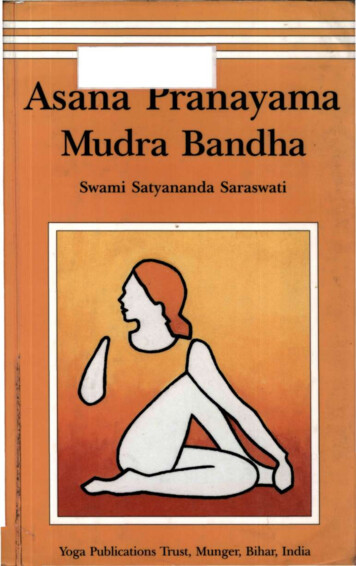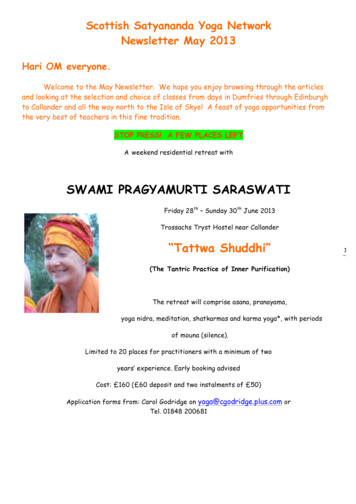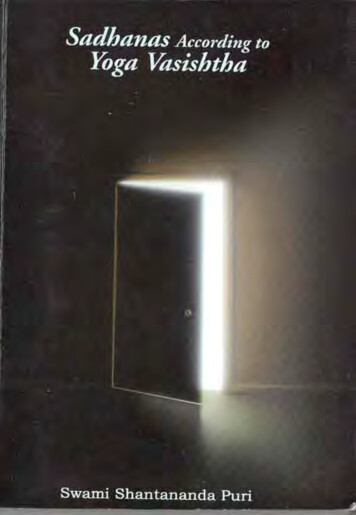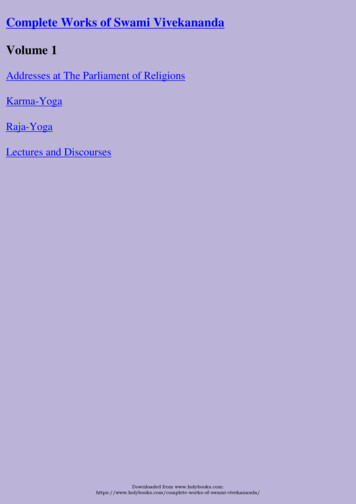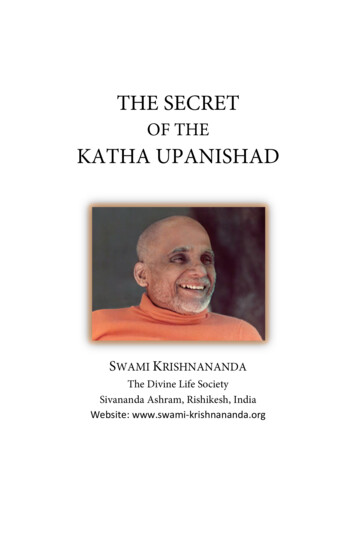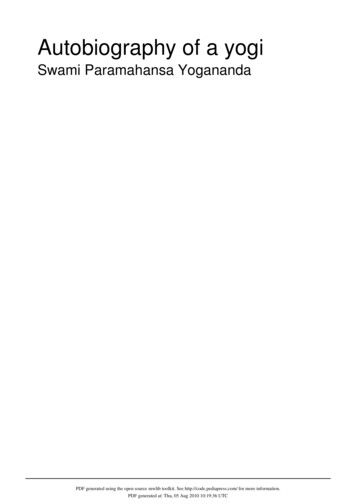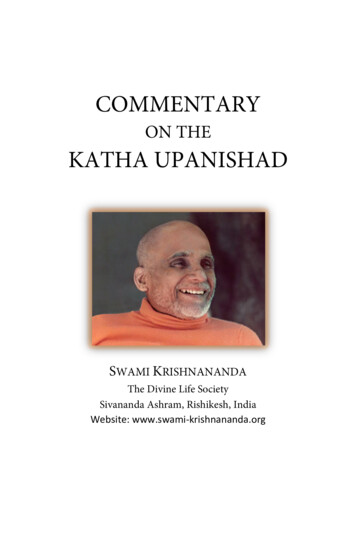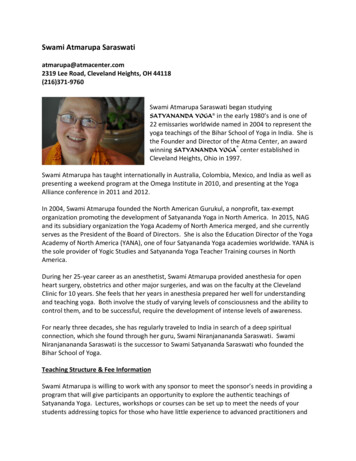
Transcription
Swami Atmarupa Saraswatiatmarupa@atmacenter.com2319 Lee Road, Cleveland Heights, OH 44118(216)371-9760Swami Atmarupa Saraswati began studyingSATYANANDA YOGA in the early 1980’s and is one of22 emissaries worldwide named in 2004 to represent theyoga teachings of the Bihar School of Yoga in India. She isthe Founder and Director of the Atma Center, an awardwinning SATYANANDA YOGA center established inCleveland Heights, Ohio in 1997.Swami Atmarupa has taught internationally in Australia, Colombia, Mexico, and India as well aspresenting a weekend program at the Omega Institute in 2010, and presenting at the YogaAlliance conference in 2011 and 2012.In 2004, Swami Atmarupa founded the North American Gurukul, a nonprofit, tax-exemptorganization promoting the development of Satyananda Yoga in North America. In 2015, NAGand its subsidiary organization the Yoga Academy of North America merged, and she currentlyserves as the President of the Board of Directors. She is also the Education Director of the YogaAcademy of North America (YANA), one of four Satyananda Yoga academies worldwide. YANA isthe sole provider of Yogic Studies and Satyananda Yoga Teacher Training courses in NorthAmerica.During her 25-year career as an anesthetist, Swami Atmarupa provided anesthesia for openheart surgery, obstetrics and other major surgeries, and was on the faculty at the ClevelandClinic for 10 years. She feels that her years in anesthesia prepared her well for understandingand teaching yoga. Both involve the study of varying levels of consciousness and the ability tocontrol them, and to be successful, require the development of intense levels of awareness.For nearly three decades, she has regularly traveled to India in search of a deep spiritualconnection, which she found through her guru, Swami Niranjanananda Saraswati. SwamiNiranjanananda Saraswati is the successor to Swami Satyananda Saraswati who founded theBihar School of Yoga.Teaching Structure & Fee InformationSwami Atmarupa is willing to work with any sponsor to meet the sponsor’s needs in providing aprogram that will give participants an opportunity to explore the authentic teachings ofSatyananda Yoga. Lectures, workshops or courses can be set up to meet the needs of yourstudents addressing topics for those who have little experience to advanced practitioners and
teachers. Some topics lend themselves to being taught from a more introductory approach butcan be built upon through an appropriate sequence taking students to a deeper level.Program booking Introductory program – this gives people an idea of what a weekend seminar containsand is useful in establishing a relationship between students and presenter. 3 hour program – this allows an introduction to theory and simple practice. Multiples of3 hour programs will allow for more depth and practice. Weekend (one theme) program – Friday evening, two 3 hour programs on Saturday andone or two 3 hour programs on Sunday. This allows for enough time to understand thetheory more deeply and to better establish some practices that can be taken home anddeveloped. Satsang – after a short introduction to a topic, this is an opportunity for students to havequestions answered. This can be useful at the beginning of a weekend program or atthe end. Havan – this is a fire ceremony with the chanting of mantras. An outdoor location andextra time for set up is required. This is often done in the early morning or evening. Weekend seminar – this can include all of the above as well as Satyananda Yoga asanaclasses. Private consultations – these are 90 minute sessions.Program ideasWithin the Satyananda Yoga tradition, the emphasis is on awareness and how deepening ourpractice of awareness can bring us more harmony in life. Most of the program ideas focus ontheory and meditation, though they may also utilize pranayama and asanas to assure abalanced approach to practice.1. Deepening your awareness through Satyananda Yoga . Beginners to Intermediate.Although many systems of yoga emphasize asana, Satyananda Yoga is designed to takethe student from the physical practices to more subtle aspects of his/her being. Thesetechniques help us tap into more subconscious and unconscious layers where we holdpatterns that prevent us from living a more harmonious life. This topic will exploredifferent techniques that move our awareness from gross to more subtle, therebyliberating energy and gaining mental strength.
2. Satyananda Yoga Nidra . Beginners to Intermediate.Relaxation is a lost art in our demanding, multitasking society. True relaxation involvesmore than resting the body. It includes letting go of the thoughts, emotions and deeplyheld impressions within the mind. Satyananda Yoga Nidra is derived from an ancienttantric technique and has been developed over the past 50 years by teachers aroundthe world. This technique not only helps to release stress, but aids in physical healingand transformation of the personality. As a pratyahara technique it is an excellentpractice to prepare for meditation.3. Introduction to Meditation. Beginners to Intermediate.Satyananda Yoga is a rich tradition with many different forms of meditation and you willhave the opportunity to practice a few methods that will assist students in makingmeditation a part of their yoga practice. In this course, learn more about the theory andpractice of meditation and how to move from relaxation to sensory withdrawal(pratyahara) to concentration (dharana).4. Prana, Pranayama and Prana Vidya. Beginners to Advanced.This topic explores prana, the vital force. Prana is experienced at different levels supporting the body’s physiological systems, supporting the mind and its ability to copewith life, and supporting the spiritual development leading to higher levels ofmeditation. Depending on the time allotted, this topic may include the theory of prana,prana vayus, nadis, chakras and preparatory practices of prana vidya. Satyananda Yogapranayama practices will also be explored. This topic can easily cover an entireweekend.5. The Complete Practice of Surya Namaskara. Intermediate to Advanced.Swami Satyanananda’s book Surya Namaskara takes the student beyond the physicalpractice by including both chakra awareness and mantra repetition. Learn more aboutthis practice called “Stress Management in a capsule” – how it balances the endocrineand nervous system. Learn the different surya mantras, bija mantras and the chakrabija mantras to deepen the practice and fully integrate the layers of our being.6. Move Forward in Life by Overcoming Resistance. Beginners to Intermediate.Most of us know what we should do to be healthier and happier, so why don’t we do it?This workshop explores the source of resistance and how to take a step by stepapproach to overcoming it. Theories of antar karana (parts of the mind), samskaras andprana are discussed to give the student more insight and strength to facility true changein life.
7. Purification of the Chakras. Intermediate to Advanced.The chakras are energy centers that determine how we live our lives – what we findimportant and how we react to situations. The theory of the chakras is more than a newage phenomena that can be looked at simplistically. This program can easily extendover a whole weekend (or longer) exploring the relationship of the gunas to the chakras,the elements, the koshas, and the symbolism of the chakras. In addition to theory,asana, pranayama and yoga nidra practices can be done with chakra awareness, as wellas practicing chakra shuddhi (purification) as a meditation.8. Become Your Own Therapist through Antar Mouna. Beginners to Intermediate.Antar Mouna means inner silence and is a step by step approach to deal with the mindboth on the meditation cushion and off. By cultivating the drashta, or witness, onebegins to distinguish the self from the endless mental chatter. The theory of the antarkarana (inner instrument of the mind) and the teachings of Patanjali will bring furtherunderstanding of the importance of this useful technique.9. Mantras. Liberating the Mind from Bondage. Beginners to Intermediate.The practice of mantras is an integral part of Satyananda Yoga. This workshop willdiscuss the theory of mantra in relationship to the mind and the chakras. Dependingon length of time, this program can include mala making, havan, kirtan and practices ofnada yoga.10. The Yoga Sutras in Daily Life – Timeless Teachings of Yoga. Intermediate.Codified by Patanjali, the Yoga Sutras are 196 aphorisms that yield the essence of Rajayoga. This program will focus on the first chapter of the Yoga Sutras and how theseteachings can be understood within the context of our daily lives.11. Yoga as Therapy. Beginners to Advanced & also a good topic for teachers.Although all yoga can be considered as therapy, the system of Satyananda Yoga with itsabundance of practices gives teachers many options to address specific healthconditions. This can be a series of workshops over a weekend – Yoga for Back Problems,Yoga for Neck and Shoulders, Yoga for Depression, etc. Or this topic can be a part of ateacher training program.
Sannyasi Atmadarshanatmadarshan@atmacenter.com2319 Lee Road, Cleveland Heights, OH 44118(216)371-9760Sannyasi Atmadarshan can provideyou with dynamic, engagingpresentations in a variety offormats. She has been teachingSATYANANDA YOGA since 2001and is a senior instructor for theYoga Academy of North America(YANA), one of four SatyanandaYoga academies worldwide. Sheteaches at international yogaevents, workshops, intensives andretreats. She was an invited lecturerfor Yoga Alliance’s inauguralconvention in 2010 and the keypresenter for North AmericanGurukul’s 2015 annual retreat inHuatulco, Mexico. With her experience and engaging personality, she will add depth andenjoyment to any type of yoga program you may desire.Sannyasi Atmadarshan is the Assistant Director of the Atma Center, an award winning SATYANANDA YOGA center established in Cleveland Heights, Ohio in 1997 and CourseCoordinator and Board Member for YANA, the sole provider of Yogic Studies and SatyanandaYoga Teacher Training courses in North America.Sannyasi Atmadarshan received her degrees in Biology and Psychology from Case WesternReserve University and worked for several years in the Laboratory of Biological Psychology atUniversity Hospitals of Cleveland. She was second author of a paper on using biologicalmarkers to predict medication response in patients with chronic schizophrenia. She taught themartial art of Aikido for over a decade and authored the internationally published book Aikidofor Kids. Sannyasi Atmadarshan has also worked in the Cleveland Heights-University HeightsPublic Library system as a story-time leader. She has made multiple visits to India, where shereceived her initiation into karma sannyasa from Paramahamsa Niranjanananda Saraswati,Swami Satyananda’s successor, in 2010.
Sannyasi Atmadarshan will work you to develop a program that meets your unique needs.Select a program type and a topic or topics from the options below:Program types Introductory – gives participants an overview of a topic and is useful in establishing arelationship between students and presenter. Can be done alone or at the start of anylonger program. 2-3 hour session – allows an introduction to theory and simple practice. Multiples ofthese sessions will allow for more depth and practice. Weekend (one theme) – Friday evening, two 3 hour programs on Saturday and one ortwo 3 hour programs on Sunday. This allows for enough time to understand the theorymore deeply and/or to better establish practices that can be taken home anddeveloped. Weekend (two themes) program – Divide the weekend programs between two themesto give your students a range of options; the themes can be related (for example, YogaPsychology and Yoga for Depression) or unrelated. Weekend seminar – this can include all of the above as well as Satyananda Yoga asanaclasses. Week-long retreat – includes morning asana/pranayama/meditation classes, morninglecture, optional lunchtime meditation, afternoon lecture, and evening program. Private consultations – 1 hour or 2 hour long appointments give students theopportunity to receive individualized attention, investigate any topic of choice, discusspersonal matters and/or receive a specific set of practices to do at home. Follow-upscan be done via Skype.TopicsWithin the Satyananda Yoga tradition, the overall emphasis is on deepening awareness tobring more harmony to all aspects of life. Specific topics can focus on theory and meditationand can utilize pranayama and asanas to deliver a more balanced approach.Four different types of topics, with many options within these categories, are available: Yoga Basics – perfect for general audiences or newer students of Satyananda Yoga Yoga Psychology – broadly appealing to yoga students, health care professionals andthe general public Yoga Philosophy – for those who want deeper explorations of specialized topics Application of Yogic Principles – for anyone wanting to learn more holistic, centeredand calm methods of daily living and professional interaction
Yoga Basics12. Deepening Your Awareness through Satyananda Yoga . Beginners to Intermediates.Although many systems of yoga emphasize asana, Satyananda Yoga is designed to takethe student from the physical practices to more subtle aspects of his/her being. Thesetechniques help us tap into more subconscious and unconscious layers where we holdpatterns that prevent us from living a more harmonious life. This topic will exploredifferent techniques that move our awareness from gross to more subtle, therebyliberating energy and gaining mental strength.13. Satyananda Yoga Nidra . Beginners to Intermediates.Relaxation is a lost art in our demanding, multitasking society. True relaxation involvesmore than resting the body. It includes letting go of the thoughts, emotions and deeplyheld impressions within the mind
asana, pranayama and yoga nidra practices can be done with chakra awareness, as well as practicing chakra shuddhi (purification) as a meditation. 8. Become Your Own Therapist through Antar Mouna. Beginners to Intermediate. Antar Mouna means inner silence and is a step by step approach to deal with the mind both on the meditation cushion and off. By cultivating the drashta, or witness, one .
